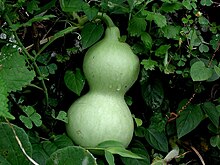Calabash
| Calabash Lagenaria siceraria |
|
|---|---|
 |
|
| Green calabash on the vine | |
| Scientific classification | |
| Kingdom: | Plantae |
| (unranked): | Angiosperms |
| (unranked): | Eudicots |
| (unranked): | Rosids |
| Order: | Cucurbitales |
| Family: | Cucurbitaceae |
| Genus: | Lagenaria |
| Species: | L. siceraria |
| Binomial name | |
|
Lagenaria siceraria (Molina) Standl. |
|
| Synonyms | |
|
|
| Nutritional value per 100 g (3.5 oz) | |
|---|---|
| Energy | 63 kJ (15 kcal) |
|
3.69 g
|
|
| Dietary fiber | 1.2 g |
|
0.02 g
|
|
|
0.6 g
|
|
| Vitamins | |
| Thiamine (B1) |
(3%)
0.029 mg |
| Riboflavin (B2) |
(2%)
0.022 mg |
| Niacin (B3) |
(3%)
0.39 mg |
| Pantothenic acid (B5) |
(3%)
0.144 mg |
| Vitamin B6 |
(3%)
0.038 mg |
| Folate (B9) |
(1%)
4 μg |
| Vitamin C |
(10%)
8.5 mg |
| Minerals | |
| Calcium |
(2%)
24 mg |
| Iron |
(2%)
0.25 mg |
| Magnesium |
(3%)
11 mg |
| Manganese |
(3%)
0.066 mg |
| Phosphorus |
(2%)
13 mg |
| Potassium |
(4%)
170 mg |
| Sodium |
(0%)
2 mg |
| Zinc |
(7%)
0.7 mg |
|
|
|
|
|
| Percentages are roughly approximated using US recommendations for adults. Source: USDA Nutrient Database |
|
The calabash, bottle gourd, or white-flowered gourd,Lagenaria siceraria (synonym Lagenaria vulgaris Ser.), also known by many other names that include: opo squash (from Tagalog: upo), long melon, suzza melon, New Guinea bean and Tasmania bean is a vine grown for its fruit, which can either be harvested young and used as a vegetable, or harvested mature, dried, and used as a bottle, utensil, or pipe. The fresh fruit has a light-green smooth skin and a white flesh. Rounder varieties are called calabash gourds. They grow in a variety of shapes: they can be huge and rounded, small and bottle shaped, or slim and serpentine, more than a metre long. Because bottle gourds are also called "calabashes", they are sometimes confused with the hard, hollow fruits of the unrelated calabash tree, Crescentia cujete, whose fruits are also used to make utensils, containers, and musical instruments. The gourd was one of the first cultivated plants in the world, grown not primarily for food, but for use as water containers. The bottle gourd may have been carried from Africa to Asia, Europe, and the Americas in the course of human migration, or by seeds floating across the oceans inside the gourd. It has been proven to be in the New World prior to the arrival of Christopher Columbus.
It is a commonly cultivated plant in tropical and subtropical areas of the world, now believed by some to have spread or originated from wild populations in southern Africa. Stands of L. siceraria, which may be source plants, and not merely domesticated stands, were reported in Zimbabwe in 2004. This apparent domestication source plant produces thinner-walled fruit that, when dried, would not endure the rigors of use on long journeys as a water container. Today's gourd may owe its tough, waterproof wall to selection pressures over its long history of domestication.
Gourds were cultivated in Africa, Asia, Europe, and the Americas for thousands of years before Columbus' discovery of America. Historically, in Europe,Walahfrid Strabo (808–849), abbot and poet from Reichenau and advisor to the Carolingian kings, discussed it in his Hortulus as one of the 23 plants of an ideal garden.
...
Wikipedia
